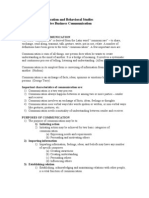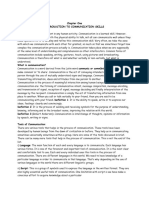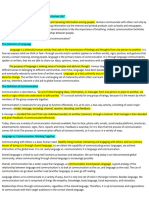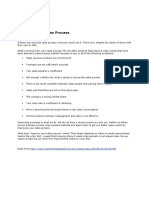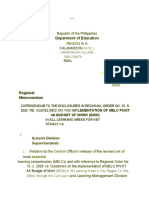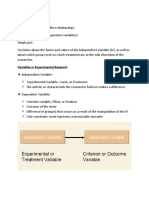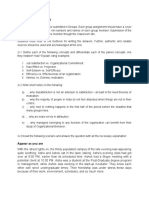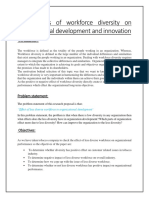Principles of Effective Business Communication
Principles of Effective Business Communication
Uploaded by
Sandip GhoshCopyright:
Available Formats
Principles of Effective Business Communication
Principles of Effective Business Communication
Uploaded by
Sandip GhoshOriginal Description:
Original Title
Copyright
Available Formats
Share this document
Did you find this document useful?
Is this content inappropriate?
Copyright:
Available Formats
Principles of Effective Business Communication
Principles of Effective Business Communication
Uploaded by
Sandip GhoshCopyright:
Available Formats
From the desk of
Ghalib Badar
www.financedoctors.net
Page | 1
Notes Business Communication and Behavioural Studies
Principles of Effective Business Communication
INTRODUCTION
CONCEPTS OF COMMUNICATION
The word communicate is derived from the Latin word communicare to share, exchange, send
along, transmit, talk, gesture, write, put in use, relate. A number of definitions have been given to the
termcommunication. A few important ones are:
Communication is sum of all things, one person does when he wants to create understanding in the
mind of another. It is a bridge of meaning. It involves a systematic and continuous process of telling,
listening and understanding. (Allen Louis)
Communication in its simplest form is conveying of information from one person to another. (Hudson)
Communication is an exchange of facts, ideas, opinions or emotions by two or more persons. (George
Terry)
Important characteristics of communication are:
1) Communication is a two way process.
2) Communication always happens between or among two or more parties sender and receiver.
3) Communication involves an exchange of facts, ideas, feelings or thoughts.
4) Communication uses verbal ways like words spoken or written, or non-verbal ways like gestures,
postures, etc.
5) Communication needs a mutuality of understanding between sender and receiver.
PURPOSES OF COMMUNICATION
The purpose of communication may be to:
1) Initiating action
Initiating action may be achieved by two basic categories of communication.
(a) Expressing needs and requirements
(b) Persuading and motivating others
2) Imparting information
Imparting information, feelings, ideas, and beliefs may have any number of specific purposes.
(a) Creating awareness
(b) Creating understanding
(c) Persuading others
(d) Influencing others
3) Establishing relation
Establishing, acknowledging and maintaining relations with other people, is a vital function of
communication.
From the desk of
Ghalib Badar
www.financedoctors.net
Page | 2
THE COMMUNICATION PROCESS / CYCLE
Before communication can take place, a purpose, expressed as a message to be conveyed is needed. It
passes between a source (the sender) and a receiver. The message is encoded (converted to a symbolic
form) and passed by way of some medium (channel) to the receiver. Who retranslates (decodes) the
message initiated by the sender. The result is the transfer of meaning from one person to another.
Communication cycle diagram
Components of communication cycle are:
1) The Source
The source is the place or the person from where the message being communicated emerges.
2) Encoding
In communication the, the act of producing message, for example, speaking or writing is
termed as encoding.
3) The Message
The message is the actual physical product from the source encoding. When we speak the
speech is the message.
4) The Channel
The channel is the medium through which the message travels. It is selected by the source, who
must determine whether to use formal or informal channel.
5) Decoding
The act of understanding messages is known as decoding. When the sound waves are translated
into ideas thus, listeners and readers are often regarded as decoders.
6) Receiver
The receiver is the object to whom the message is directed. But before the message can be
received, the symbols in it must be translated into a form that can be understood by the
receiver.
7) Feedback
The final link in the communication process is a feedback loop. Feedback is the check on how
successful we have been, in transferring our messages as originally intended.
Source Encoding
Channel
Decoding
Receiver
From the desk of
Ghalib Badar
www.financedoctors.net
Page | 3
NON-VERBAL COMMUNICATION
Numerous articles and books have been written on the importance of non-verbal messages. Some
studies suggest that from 60 to 90 percent of a messages effect comes from nonverbal cues. This
section presents a brief overview of nonverbal communication:
Body language
Sign language
Paralanguage
Circumstantial language space, surroundings and time
Body language
Body language is the way the body communicates by its physical movements. When we study body
language, we specifically look for inner states of emotion as expressed through different parts of the
body and their physical movements. Body language mainly includes following subparts:
a) Facial expressions:
The facial expressions can divulge hidden emotions anger, annoyance, confusions, enthusiasm,
fear, hatred, joy, love, interest, sorrow, surprise, uncertainty and others. They can also
contradict verbal statements.
b) Eye contact:
Within the facial area, the eyes tell us much than other facial features. The eyes, along with the
eyebrows, upper and lower eyelids, and size of pupils, convey some inner body state. In fact, eye
contact may be the best indicator of how involved a person is in the situation.
c) Posture:
Posture is the way we carry ourselves. Like we may choose to stand or sit erect, or lean forward
or backward, or slouch haphazardly. Postures non-verbally convey impressions of self-
confidence, status and interest.
d) Gestures:
Gestures are the physical movements of the arms, legs, hands, torso and head. When you are
speaking some gestures have standard meanings for example, touching and tapping your
forefinger to the top of your head means you are thinking, a slight variation with a single rapid
tap means you have an idea.
e) Body shape:
The physical shapes of our body also communicate to others. Like tallness usually equates with
dominance. We cannot do much about the shape of our body, but by adopting right kind of
postures and dressing style, we can improve the impact of our physical appearance.
f) Smell and touch:
Various odors and artificial fragrances on human beings can sometimes convey emotions and
feelings better than words. Similarly, touching people in different ways can silently
communicate friendship, love, approval, hatred, anger or other motives and feelings.
g) Silence:
Silence can be a positive or negative influence in the communication process. It can provide a
link between messages or sever relationships. It can create tension and uneasiness or create a
peaceful situation.
From the desk of
Ghalib Badar
www.financedoctors.net
Page | 4
Sign language
The most basic element of communication is the sign. A sign is a symbol. A symbol is something that
stands for something else. Everything in our world that we can visualize or sense has symbolic meaning
and can be used in communication. For example, a map is a symbol that represents an actual physical
geographic territory, and the 21 gun salute is a symbol of respect.
Paralanguage
Another type of non-verbal communication is known as paralanguage or paralinguistic. Of all non-verbal
types, it is the closest to the actual communication. Para means like; thus paralanguage literally
means like language. This like language is the where we use our voice in uttering words. It is
everything other then words-intonation, pitch, regional accent, sarcasm, hesitations, truthfulness,
emotion, etc.
a) Pitch variation how high or low your vocal tones are.
b) Volume refers to the loudness of the voice.
c) Speed and pause speaking in a very high speed may make the matter incomprehensible and at
too low speed may make the matter boring. Thus a speaker should use normal pace.
d) Stress on words by emphasizing different key words in a sentence you can purposely indicate
your feelings about what is important.
Circumstantial language
One of the very interesting aspect of communication is that its not the person only who communicates.
Actually everything about him and his surroundings communicates. Some of the circumstantial factor
which communicates about the person are discussed below:
a) Space language (proxemics):
Proxemics is personal space language. Countless messages are communicated by the way
people use space around them, the way they claim that space for themselves, or the way they
share it.
b) Surroundings:
Surroundings convey status. Aspects of surroundings include room size, location, furnishing, wall
decoration, floor (carpeted or bare), lighting, windows, the way you arrange objects in your
work area.
c) Time (chronemics):
The way we use our time provides a number of silent messages. Most rules about informal times
are not taught and are generally practiced unconsciously. For example Punctuality of a person,
time given to a task by a person, etc.
LISTENING
Johnson defines listening as the ability to understand and respond effectively to oral communication.
Listening requires more than hearing. It requires the understanding of the message received. Davis
states it in this way hearing is with the ears, but listening is with the mind. Thus, we can say that
hearing is not listening.
From the desk of
Ghalib Badar
www.financedoctors.net
Page | 5
Steps to improve listening capability:
The ability to listen more effectively may be acquired through discipline and practice. For a good
listening a listener must be physically relaxed and mentally alert to receive and understand the message.
Here are some steps for effective listening, if followed, can appreciably increase the effectiveness of this
communicative skill:
1) Realize that listening is a hard work
2) Prepare to listen
3) Have positive attitude
4) Resist distractions
5) Listen to understand, not refute
6) Keep an open mind
7) Find an area of interest
8) Concentrate on the context
9) Capitalize on thought-speed
10) Combine verbal delivery with non-verbal clues
11) Show some empathy
12) Be patient
13) Listen critically and delay judgment.
Different ways of listening:
Listening may have a number of purposes, which should be borne in mind as you listen.
a) Listening for content if you trust the source of the message and want to know the sources
viewpoint, listening for content will be a straight forward receiving activity.
b) Critical listening if you require an accurate information and you have not absolute confidence
that the source is able to give it to you, you will need to listen critically.
c) Empathetic listening is the power of understanding and imaginatively entering into another
persons feelings.
LEVELS OF COMMUNICATION
1) Intrapersonal communication communication with oneself.
2) Impersonal communication mass communication, in which the message is directed to a large,
diffuse audience.
3) Interpersonal communication individual to individual, individual to group and group to
individual.
PROBLEMS OF COMMUNICATION
Problems of communication include:
1) Failure to plan for communication
2) Omission or overload of information
3) Misunderstanding due to technical jargon
4) Non-verbal signals confusing the recipient.
5) Difference in social, racial or educational background
6) Perceptual or selectivity
7) Poor reading or listening skills
8) Failure to seek or offer feedback
9) Lack of credibility
10) Noise and distortion is communication channel
From the desk of
Ghalib Badar
www.financedoctors.net
Page | 6
Noise:
Noise refers to distractions and interference in the environment in which communication takes place.
a) Physical nose noise in surroundings
b) Technical noise failure in the channel or medium of communication
c) Social noise difference in personality, culture or outlook of the sender and receiver.
d) Psychological noise excessive emotion, prejudice or nervousness
e) Semantic noise use of different language, not understandable to receiver.
Distortion:
Distortion refers to the way in which the meaning of a communication is lost in handling.
Problems of communication can be overcome by:
1) Proper planning of message
2) Not to omitting or overloading of information
3) Avoiding technical jargon and non-verbal cues
4) Checking the recipients status
5) Using appropriate channel or medium
6) Trying to make the source credible
7) Using free from bias language
BASIC PRINCIPLES
SEVEN Cs OF EFFECTIVE COMMUNICATION
To compose effective written or oral messages, you must apply certain communication principles. These
principles provide guidelines for choice of content and style of presentation, adapted to the purpose and
receiver of your message. Called the seven Cs they are completeness, conciseness, consideration,
concreteness, clarity, courtesy and correctness.
1.Completeness:
Your business message is complete when it contains all facts the reader or listener needs for the
reaction you desire. As you strive for completeness, keep the following guidelines in mind:
a) Provide all necessary information answering the five Ws helps make messages clear: who,
what, when, where and why.
b) Answer all questions asked look for questions: some may even appear buried within a
paragraph. Locate them and answer them precisely.
c) Give something extra, when desirable use your good judgment in offering additional material
if the senders message was incomplete.
2.Conciseness:
Conciseness is saying what you have to say in the fewest possible words without sacrificing the other C
qualities. A concise message is complete without being wordy. To achieve conciseness, observe the
following suggestions:
a) Eliminate wordy expressions use single word in place of phrases. For example, use now
instead of at this time.
b) Include only relevant material delete irrelevant words and rambling sentences.
c) Avoid unnecessary repetition it leads to dullness.
From the desk of
Ghalib Badar
www.financedoctors.net
Page | 7
3.Consideration:
Consideration means preparing every message with the message receivers in mind, try to put yourself in
their place. Three specific ways to indicate consideration are:
a) Focus on you attitude instead of I and we using you does help project a you-attitude.
But overuse can lead to a negative reaction.
b) Show audience benefit or interest in the receiver readers may react positively when benefits
are shown them.
c) Emphasize positive, pleasant facts because of past connections with words, readers will react
positively or negatively to certain words.
4.Concreteness:
Communicating concretely means being specific, definite, and vivid rather than vague and general.
Often it means using denotative (direct, explicit, often dictionary-based) rather than connotative words
(ideas or notions suggested by or associated with a word or phrase). The following guidelines should
help you compose concrete, convincing messages.
a) Use specific facts and figures whenever possible, use an exact, precise statement or a figure in
place of a general word to make your message more concrete.
b) Put action in your verbs active verbs help make your message more specific, personal, concise
and emphatic.
c) Choose vivid, image-building words business writing uses less figurative language than does
the world of fiction.
5.Clarity:
Getting the meaning from your head into the head of your reader ----accurately---- is the purpose of
clarity.
a) Choose precise, concrete and familiar words when meaning of words is in doubt, use more
familiar words; audiences will understand them better.
b) Construct effective sentences and paragraphs important characteristics to consider are length
(between 17 and 20 word for an average sentence), unity, coherence and emphasis (put main
ideas up front within a sentence).
6.Courtesy:
Knowing your audience allows you to use statements of courtesy; be aware of your message receiver.
The following are the suggestions for generating a courteous tone:
a) Be sincerely tactful, thoughtful and appreciative
b) Use expressions that show respect omit irritating expressions and questionable humor.
c) Choose nondiscriminatory expressions
7.Correctness:
At the core of correctness is proper grammar, punctuation and spelling. However, a message may be
perfect grammatically and mechanically but still insult or lose a customer. The term correctness, as
applied to business messages, also means the following three characteristics:
a) Use the right level of language
b) Check accuracy of figures, facts and words a good check of your data is to have another person
read and comment on the validity of the material.
c) Maintain acceptable writing mechanics.
From the desk of
Ghalib Badar
www.financedoctors.net
Page | 8
INTERPERSONAL COMMUNICATION (IPC)
COMPONENTIAL DEFINITION
By Harold (5 components)
Who says What In what channel To whom With what effect.
By George (10 components)
Someone perceives an event And reacts In a situation Through some means to make
available material In some form And context conveying contents of some consequence.
UNIVERSALS OF IPC
Features those are present in all interpersonal communication acts on called universals. These are as
follows:
1) Source-Receiver at least to persons must be present for an IPC to take place.
2) Encoding-Decoding reducing a message to the written or the spoken word.
3) Competence and performance performance depends upon the language used in encoding-
decoding and communication techniques.
4) Messages and their channeling messages sent are signals that act as a stimulus for a receiver
and channel is the medium through which a message is conveyed.
5) Noise in exchange of message an element of distortion enters through noise. It may be
physical, psychological and semantic.
6) Feedback it may be a self feedback or feedback from others.
7) Context communication perforce takes place in a context. It may be a:
a) Physical dimension the place where communication takes place.
b) Social/psychological dimension the status relationship amongst the participants.
c) Temporal dimension this may include not only time but also the fitness of communication
in the sequence of surrounding events.
8) Field of experience effective communication takes place to the extent that the participants
share the same experiences. The larger the difference between the fields of experience the
more difficult the communication would become.
9) Effects the effects of communication are not always visible and therefore are personal.
10) Ethics personal philosophy of ones life, they are therefore not prone to formalization.
AXIOMS OF IPC
1) Inevitability of communication:
We are communicating even though we might not think we are or might not even want to
communicate. Whether she or he wishes to or not; we cannot not communicate. Our silence in
response also communicates.
2) Irreversibility of communication:
IPC is an irreversible process. We can never undo what has already been done. What has been
communicated remains communicated. Although we may try to qualify, negate, or somehow
reduce the effects of our message, the message itself, once it has been sent and received,
cannot be reversed.
3) Contents and relationship dimensions of communication:
A number of problems in IPC arise by a lack of balancing between the contents and the
relationship dimensions of a communication. Contents of the communication may generally
From the desk of
Ghalib Badar
www.financedoctors.net
Page | 9
relate to the speaker or the listener and the communication may also be indicative of the
relationship existing between the speaker and the listener.
4) Communication involving a process of adjustment:
We realize that no two persons share identical signal systems. Parents and children, for
example, not only have different vocabularies to a very great extent but, even more important,
have different meanings for the terms they have in common.
5) Defining relationship by punctuation:
Communication events are continuous transactions. They are broken up into short sequences
only for purposes of convenience. What is stimulus and what is response is not very easy to
determine when we, as analysts of communication, enter after the communication transaction
is under way.
6) Symmetrical and complementary view of interactions:
In a symmetrical relationship, the two individuals mirror each others behavior. If one express
jealousy, the other will also express jealousy. In a complementary relationship, the two
individuals engage in different behaviors, with the behavior of one serving as the stimulus for
the complementary behavior of the other.
TYPES OF IPC
This includes:
a) Individual to individual
b) Individual to group
c) Group to individual
d) Between groups
Compiled by: Ghalib Badar
Reviewed by: Kashif Adeel-ACA
You might also like
- Communication Skills Self Study Notes-1 PDFDocument37 pagesCommunication Skills Self Study Notes-1 PDFJoshua Hynes85% (33)
- Stop OverthinkingDocument75 pagesStop OverthinkingMark anthony Palabay100% (1)
- Module 1 Purposive Communication - 21st Century CommunicationDocument48 pagesModule 1 Purposive Communication - 21st Century CommunicationRovin Jae Esguerra86% (7)
- DLL Agricultural Crop TLE Grade 7Document14 pagesDLL Agricultural Crop TLE Grade 7CharlesBallesteros85% (20)
- Lesson 1: Communication Processes, Principles, and Ethics Learning OutcomesDocument8 pagesLesson 1: Communication Processes, Principles, and Ethics Learning OutcomesGladys Campos67% (3)
- How Customers ThinkDocument16 pagesHow Customers ThinkPatricio Javier Órdenes100% (1)
- Non-Verbal CommunicationDocument2 pagesNon-Verbal CommunicationNirvana OshoNo ratings yet
- COmmunication For B. Ed NotesDocument7 pagesCOmmunication For B. Ed NotesManoj Yadav83% (12)
- Im Happy Sad Today Preview 1Document6 pagesIm Happy Sad Today Preview 1AiraNo ratings yet
- Concepts of CommunicationDocument15 pagesConcepts of CommunicationTanzeel Khan0% (1)
- Notes Business Communication and Behavioural Studies PDFDocument12 pagesNotes Business Communication and Behavioural Studies PDFZaheer Ahmad RazaNo ratings yet
- Business Communication and Behavioural StudiesDocument10 pagesBusiness Communication and Behavioural StudiesBhujangam NaiduNo ratings yet
- CommunicationDocument19 pagesCommunicationMd. Tamim IqbalNo ratings yet
- Communication Skills: (I) Source/Sender/Encoder: The Communication Process Begins With The Sender Who Is TheDocument11 pagesCommunication Skills: (I) Source/Sender/Encoder: The Communication Process Begins With The Sender Who Is TheAgha Khan DurraniNo ratings yet
- Business CommunicationDocument8 pagesBusiness CommunicationAnumeha Srivastava100% (2)
- Business Communication: PortfolioDocument13 pagesBusiness Communication: PortfolioFurqan MahmoodNo ratings yet
- ETC Question BankDocument19 pagesETC Question BankRutvika GhadiyaliNo ratings yet
- Introduction of Communication SkillsDocument75 pagesIntroduction of Communication Skillsملك الأسلوبNo ratings yet
- Communication Skills Notes AutosavedDocument122 pagesCommunication Skills Notes Autosavedmunaxemimosa69No ratings yet
- Communication Skills NotesDocument122 pagesCommunication Skills NotesSALOME KORIR100% (2)
- Module 1 - PurcomDocument23 pagesModule 1 - PurcomLarry Gerome De GuzmanNo ratings yet
- Eng 03-Speech Communication Topic One Speech: Its Nature and ImportanceDocument4 pagesEng 03-Speech Communication Topic One Speech: Its Nature and ImportanceStevenzel Eala EstellaNo ratings yet
- Purposive Communication, Introduction to CommunicationDocument4 pagesPurposive Communication, Introduction to Communicationanggelia25anggelesNo ratings yet
- Business CommunicationDocument30 pagesBusiness CommunicationDorina MogildeaNo ratings yet
- Purcom ReviewerDocument35 pagesPurcom ReviewerHoneycris AguilarNo ratings yet
- Communication Part 1-1Document9 pagesCommunication Part 1-1ABINASH KALITANo ratings yet
- Effective Communication Aom PPT 3 PrelimDocument23 pagesEffective Communication Aom PPT 3 PrelimJhaymaeca BajilloNo ratings yet
- Screenshot 2023-10-09 at 10.47.46Document5 pagesScreenshot 2023-10-09 at 10.47.46Natali PardosiNo ratings yet
- Non Verbal CommunicationDocument8 pagesNon Verbal CommunicationGopal SukhwalNo ratings yet
- INSTFONTANA - LINGUISTCA 1eroDocument7 pagesINSTFONTANA - LINGUISTCA 1eroLucas AyalaNo ratings yet
- Business Communication Unit 1Document33 pagesBusiness Communication Unit 1B.MIRUDHULANo ratings yet
- Communication Lyst3955Document19 pagesCommunication Lyst3955Kranti TejanNo ratings yet
- Communication Notes PDFDocument122 pagesCommunication Notes PDFTinashe ChikariNo ratings yet
- Non-Verbal CommunicationDocument2 pagesNon-Verbal Communicationruffy3020No ratings yet
- What Is ComunicationDocument9 pagesWhat Is ComunicationShambhu KumarNo ratings yet
- TECHNICAL COMMUNICATION Notes...Document28 pagesTECHNICAL COMMUNICATION Notes...Irfan RashidNo ratings yet
- Non COMMUNICATIONDocument8 pagesNon COMMUNICATIONved prakash raoNo ratings yet
- Topic 9 - Forum Question 1. Explain The Meaning of Communication and Describe What Is Non-Verbal CommunicationDocument3 pagesTopic 9 - Forum Question 1. Explain The Meaning of Communication and Describe What Is Non-Verbal CommunicationHadi azfar channelNo ratings yet
- Lesson 1 OutlineDocument5 pagesLesson 1 OutlineXHYRICH ISLETANo ratings yet
- Hand Outs in Ed 403 AutosavedDocument7 pagesHand Outs in Ed 403 Autosavedjenessa abrasaldoNo ratings yet
- LG 102 LectureDocument532 pagesLG 102 Lectureanime admirersNo ratings yet
- PCO Module 1 Introduction To CommunicationDocument24 pagesPCO Module 1 Introduction To CommunicationSandreiAngelFloresDuralNo ratings yet
- Reviewer Oral CooomDocument8 pagesReviewer Oral CooomNiña Michaela G. ColobongNo ratings yet
- Chapter 1. Lesson 1 - Communication, Importance and ProcessDocument5 pagesChapter 1. Lesson 1 - Communication, Importance and ProcessHazel HediaNo ratings yet
- Unit - 1 Business Communication - FYBBA Sem-1 - GeneralDocument28 pagesUnit - 1 Business Communication - FYBBA Sem-1 - Generalpmeet8074No ratings yet
- CommunicationDocument89 pagesCommunicationChristine LeroyNo ratings yet
- Ai Support Material Class 9-1Document8 pagesAi Support Material Class 9-1sunayskvs4aNo ratings yet
- Purp ComDocument20 pagesPurp CommaxynnerhaediololaNo ratings yet
- Mba BUSINESS COMMUNICATION SLIDEDocument40 pagesMba BUSINESS COMMUNICATION SLIDEABHI100% (3)
- Chapter One SkillsDocument17 pagesChapter One Skillstalex0628No ratings yet
- 1.1 Communication Edit PDFDocument5 pages1.1 Communication Edit PDFguerrerolejan1No ratings yet
- Verbal and Non Verbal CommnunicatioDocument5 pagesVerbal and Non Verbal Commnunicatioyasir_memon89_334319No ratings yet
- Communication Skills. First Years. Lesson 1Document21 pagesCommunication Skills. First Years. Lesson 1Isaac KalungaNo ratings yet
- Interpersonal SkillsDocument3 pagesInterpersonal SkillsFyness ChiwandaNo ratings yet
- Non-Verbal Comm PaperDocument5 pagesNon-Verbal Comm PaperAriza AyoshiNo ratings yet
- DIASSDocument6 pagesDIASSAbby Gale CamungayNo ratings yet
- Assignment Thay CôngDocument31 pagesAssignment Thay CôngHinHinNo ratings yet
- Communication: PROFESSIONAL. Desired Communication Skills Vary From One Career ToDocument11 pagesCommunication: PROFESSIONAL. Desired Communication Skills Vary From One Career ToJershane MacamNo ratings yet
- ENG Short NotesDocument23 pagesENG Short Notesb423069No ratings yet
- Topic 1 - Intro To CommunicationDocument11 pagesTopic 1 - Intro To CommunicationLiam MaghanoyNo ratings yet
- Lecture 01Document31 pagesLecture 01Hammad FarooqNo ratings yet
- Concepts of Speech and CommunicationDocument3 pagesConcepts of Speech and CommunicationHuey Asejo100% (1)
- The Complete Communication & People Skills Training: Master Small Talk, Charisma, Public Speaking & Start Developing Deeper Relationships & Connections- Learn to Talk To AnyoneFrom EverandThe Complete Communication & People Skills Training: Master Small Talk, Charisma, Public Speaking & Start Developing Deeper Relationships & Connections- Learn to Talk To AnyoneNo ratings yet
- Masta SDG SeriesDocument26 pagesMasta SDG SeriesSandip GhoshNo ratings yet
- Improve Your Sales ProcessDocument12 pagesImprove Your Sales ProcessSandip GhoshNo ratings yet
- Business PlansDocument51 pagesBusiness PlansSandip GhoshNo ratings yet
- Short Sale Coordination Package: Print ... Save As ..Document21 pagesShort Sale Coordination Package: Print ... Save As ..Sandip GhoshNo ratings yet
- SNL 3138 + 22236 K + H 3136Document2 pagesSNL 3138 + 22236 K + H 3136Sandip GhoshNo ratings yet
- Chapter 5 - Friction Devices - Theory of Machines - Part 1Document17 pagesChapter 5 - Friction Devices - Theory of Machines - Part 1Sandip GhoshNo ratings yet
- Chapter 3 - Belts, Ropes and Chains - Theory of Machines - Part 1Document18 pagesChapter 3 - Belts, Ropes and Chains - Theory of Machines - Part 1Sandip Ghosh100% (2)
- Product Description Designation Alternative Designation UMC D D B MinDocument104 pagesProduct Description Designation Alternative Designation UMC D D B MinSandip GhoshNo ratings yet
- Comparing Annual Report of Mahindra Satyam and Infosys For The YEAR 2011-12Document26 pagesComparing Annual Report of Mahindra Satyam and Infosys For The YEAR 2011-12Sandip GhoshNo ratings yet
- Competency Based Interview Questions: Knowledge BaseDocument5 pagesCompetency Based Interview Questions: Knowledge BaseSandip GhoshNo ratings yet
- Communication Case Study 2Document10 pagesCommunication Case Study 2Sandip GhoshNo ratings yet
- Barriers To Effective Communication: A Presentation By, Subodh, MBA Agri-Food BusinessDocument16 pagesBarriers To Effective Communication: A Presentation By, Subodh, MBA Agri-Food BusinessSandip GhoshNo ratings yet
- Breaking The Language Breaking The Language Barriers BarriersDocument28 pagesBreaking The Language Breaking The Language Barriers BarriersSandip GhoshNo ratings yet
- 11Document4 pages11Sandip GhoshNo ratings yet
- Indian Contract ActDocument8 pagesIndian Contract ActSandip GhoshNo ratings yet
- Sales Presentation Rev 9Document21 pagesSales Presentation Rev 9Sandip GhoshNo ratings yet
- Tsubaki Steel Mill ChainsDocument10 pagesTsubaki Steel Mill ChainsSandip GhoshNo ratings yet
- Standard Simplex Method ExampleDocument2 pagesStandard Simplex Method ExampleSandip GhoshNo ratings yet
- RPH Week 2 2020Document15 pagesRPH Week 2 2020dgisneayuNo ratings yet
- Mass Communication NotesDocument81 pagesMass Communication NotesAnamta KhanNo ratings yet
- Language MilestonesDocument2 pagesLanguage Milestonesapi-306652917No ratings yet
- Child and Family Health Practice FrameworkDocument37 pagesChild and Family Health Practice Frameworkwildan yogaNo ratings yet
- Asking and Answering QuestionsDocument4 pagesAsking and Answering QuestionsShiela Mae Mendoza100% (1)
- Sample Research Paper PDFDocument65 pagesSample Research Paper PDFJess IglesiasNo ratings yet
- Love LanguageDocument2 pagesLove Language8rvz5qg7rmNo ratings yet
- TeacherDocument4 pagesTeacherkinayath@yahoo.comNo ratings yet
- Easing The Transition From Students To NursesDocument22 pagesEasing The Transition From Students To Nursesjohn michael olivares67% (3)
- Coach Others in Job Skills 310812Document117 pagesCoach Others in Job Skills 310812Nga NguyenNo ratings yet
- Of Philippines: DepartmentDocument69 pagesOf Philippines: DepartmentAmpaul Parocha100% (2)
- Amia Srinivasan - Genealogy, Epistemology and WorldmakingDocument30 pagesAmia Srinivasan - Genealogy, Epistemology and WorldmakingcatNo ratings yet
- The Relationship Between Emotional Maturity and Psychosocial Adjustment Among First-Year Undergraduate Students in Amhara Region Public Universities, EthiopiaDocument11 pagesThe Relationship Between Emotional Maturity and Psychosocial Adjustment Among First-Year Undergraduate Students in Amhara Region Public Universities, EthiopiaYared FentawNo ratings yet
- Experimental ResearchDocument6 pagesExperimental ResearchMani PNo ratings yet
- Social ControlDocument4 pagesSocial ControlSatyam PathakNo ratings yet
- Essay On Taking Charge of One's Health.Document2 pagesEssay On Taking Charge of One's Health.ALIESON KEITH SANCHEZNo ratings yet
- The Dynamics of Positivism in The Study PDFDocument32 pagesThe Dynamics of Positivism in The Study PDFArvind HoodaNo ratings yet
- OB Assignment (Group)Document4 pagesOB Assignment (Group)FAGUN SONINo ratings yet
- The Effects of Workforce Diversity On Organizational Development and InnovationDocument6 pagesThe Effects of Workforce Diversity On Organizational Development and InnovationIqraShaheen100% (1)
- Acting Without Thinking-1Document3 pagesActing Without Thinking-1srikanthchinthuNo ratings yet
- Love Is The Most Significant Thing in Human's Life. Each: ScienceDocument3 pagesLove Is The Most Significant Thing in Human's Life. Each: ScienceRits MonteNo ratings yet
- McClellands TheoryDocument2 pagesMcClellands TheoryJC SabasNo ratings yet
- GPREC Soft SkillsDocument12 pagesGPREC Soft SkillstechnologyonofficialNo ratings yet
- Modifiers of Human ActsDocument6 pagesModifiers of Human ActsolofuzyatotzNo ratings yet
- Curriculum Vitae2020uDocument7 pagesCurriculum Vitae2020uapi-524841647No ratings yet
- MoodCheck BPonlyDocument3 pagesMoodCheck BPonlyIgnacio Victor Gutierrez100% (1)











